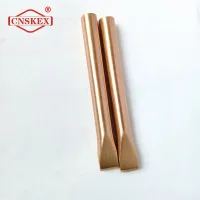Non-sparking flat chisels are specialized tools designed for use in environments where there is a risk of fire or explosion due to flammable gases, vapors, or dust. These tools are particularly critical in industries such as oil and gas, mining, and chemical processing, where the safety of workers and equipment is paramount. This article delves into the specific applications and advantages of non-sparking flat chisels, addressing common questions and concerns from end users.
Non-sparking flat chisels are primarily used for cutting, shaping, or removing materials in potentially hazardous environments. The unique properties of these chisels make them essential tools for various applications.
In industries where flammable materials are present, using standard chisels can create sparks from metal-on-metal contact. Non-sparking flat chisels are made from materials such as brass or aluminum, which do not generate sparks. This characteristic makes them ideal for removing coatings, paint, or debris without posing a risk of ignition. For example, during maintenance work in a refinery, these chisels can safely remove insulation or seals without igniting flammable vapors.
Custom Non-sparking flat chisels are also valuable in demolition and renovation projects. Their flat design allows for precise cutting and shaping, enabling workers to remove concrete, brick, or mortar without damaging surrounding structures. This is particularly beneficial in confined spaces where minimizing collateral damage is crucial. For instance, during renovations in chemical plants, these chisels can be used to carefully dismantle equipment while maintaining a safe work environment.
These chisels can effectively work with various materials, including metals, plastics, and wood. This versatility makes them suitable for a wide range of applications, from construction to maintenance and repair. In the aerospace industry, for example, non-sparking flat chisels can be used to work on components without the risk of igniting flammable substances often found in fuel lines or hydraulic systems.

Selecting the appropriate non-sparking flat chisel involves considering several factors to ensure optimal performance and safety.
Non-sparking chisels come in different materials, such as brass, copper, or aluminum. Each material has unique properties that affect its performance. For instance, brass chisels are highly resistant to corrosion and can withstand high-impact applications, making them suitable for heavy-duty tasks. Understanding the specific requirements of your project will help in selecting the right material.
Suggested reading:Flat chisels are available in various sizes and shapes. The choice of size should correspond to the intended use. A wider chisel may be needed for large surface areas, while a narrower one may be ideal for detailed work. Additionally, the angle of the chisel’s edge can impact its cutting efficiency; therefore, selecting the correct shape for your task is essential.
Ensure that the non-sparking flat chisels you choose meet industry safety standards. Look for tools that are certified for use in hazardous environments. Compliance with standards such as OSHA and NFPA can help prevent accidents and ensure the safety of workers.
Proper maintenance of non-sparking flat chisels is crucial to extend their lifespan and ensure their effectiveness.
Inspect chisels regularly for signs of wear, damage, or corrosion. Any chisel that shows significant wear should be replaced to avoid compromising safety and performance. This is especially important in environments where equipment failure could lead to dangerous situations.
After use, clean chisels thoroughly to remove any debris or residues that may accumulate. This will help prevent corrosion and ensure that the chisels maintain their non-sparking properties.
Store non-sparking chisels in a clean, dry environment. Using tool organizers can help keep them secure and prevent accidental damage. Avoid storing them with regular metal tools to reduce the risk of confusion and improper use.
Non-sparking flat chisels are invaluable tools in various industries, providing safe and efficient solutions for cutting, shaping, and material removal in hazardous environments. By understanding their applications, choosing the right tools, and implementing proper maintenance practices, end users can significantly enhance workplace safety and operational efficiency. Always prioritize safety by selecting tools that meet industry standards and suit your specific needs.
Suggested reading:
Comments
Please Join Us to post.
0